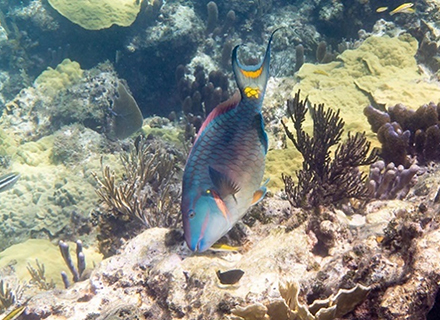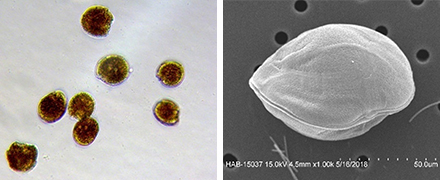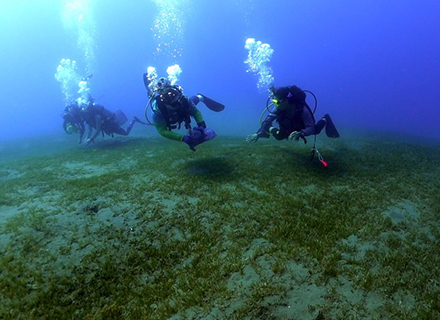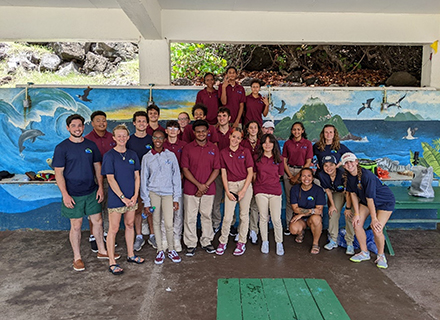By Maggie Wiener

NIEHS and the National Science Foundation (NSF) jointly fund research on marine-related health issues through the Centers for Oceans and Human Health program. Within this program, the Greater Caribbean Center for Ciguatera Research (GCCCR) was established as a center of excellence in the study of ciguatera poisoning, one of the most prevalent seafood-borne illnesses globally. As part of the GCCCR, various researchers aim to determine how climate change affects the production, fate, and transport of ciguatoxins - a natural marine neurotoxin - and to uncover the mechanisms of toxin uptake, transmission, and exposure that ultimately lead to human illness.
Alison Robertson, Ph.D., is an assistant professor in the School of Marine and Environmental Sciences at the University of South Alabama, senior marine scientist at the Dauphin Island Sea Lab, and a co-investigator and research project lead in the GCCCR. Her teams work to further overall understanding of how ciguatoxins enter the food web and how organisms modify, cope, and adapt to toxin exposure. They seek to identify biomarkers of ciguatoxin exposure to help detect contaminated seafood before it reaches consumers and to develop diagnostic and therapeutic tools that may alleviate the effects of those suffering with ciguatoxin poisoning.
"A large part of our work over the last decade has been trying to elucidate the organisms, the toxins, and the pathways they take as they move into the food web so we can move toward better predictive capacity and to turn these findings into tools that protect people," said Robertson.
Ciguatoxin Poisoning and Ciguatoxins
Ciguatoxin poisoning in people is caused by the consumption of seafood that are contaminated with ciguatoxins. These toxins and their precursors are produced by certain species of Gambierdiscus and Fukuyoa dinoflagellates, microscopic marine algae, that live on macroalgae, seagrasses, and other substrates such as dead corals and sand. Ciguatoxins are taken up by marine organisms that graze on the substrates harboring the toxin-producing microalgae and are then transferred through the food web to fish commonly caught and eaten by seafood consumers.

Ciguatoxins have been reported in many regions around the world , including the northern Gulf of Mexico, throughout the Caribbean Sea, and the tropical Pacific, including Hawaii, Japan, French Polynesia, Indonesia, and Australia. In recent years, the increase in global seafood trade has also led to ciguatoxin outbreaks in temperate regions like New York, Germany, and the United Kingdom, expanding the range of concern.
Knowledge of ciguatoxin poisoning is limited, and the disease is typically underreported or misdiagnosed. Acute symptoms appear within hours following ingestion of a meal contaminated with ciguatoxins and are observed in almost all organ systems - gastrointestinal, cardiovascular, and neurological. Dominant symptoms of Caribbean ciguatoxin exposure include nausea, vomiting, diarrhea, tingling and numbness, itching, fatigue, dizziness, muscle weakness, and pain.
Ciguatoxins are extremely potent but present at trace levels in affected fish, so they can be difficult to detect and quantify without sensitive and advanced analytical tools. Typically, protective measures include avoidance of certain fish species implicated in ciguatera or from certain areas and size restrictions. In areas where ciguatoxin is prevalent and persistent, however, these actions are often insufficient to protect consumers.

Monitoring benthic algal populations - algae that typically grow at the bottom of a body of water - can also aid in the assessment of seasonal variations in ciguatoxins on the reef. However, this effort can be time intensive compared to monitoring harmful algal blooms (HABs) in open waters. As opposed to taking a simple water sample from the side of a boat, natural substrates, like macroalgae and seagrass, or artificial substrates need to be collected underwater and processed to remove and isolate the toxigenic organisms that live on them.
In a ciguatoxic fish, the organs, eggs, head, skin, and bones often have the highest levels of toxins, so removal of these may reduce exposure and is good practice. Ultimately, working with local communities, fishermen, resource managers, and healthcare providers to expand the knowledge of ciguatera poisoning through public outreach programs is one of the best protective strategies.
"With the effects of climate change, there is a real need for increased education and awareness of ciguatera, particularly in areas where ciguatera is just starting to emerge, and an even greater need for effective pre-harvest fish testing and treatments," Robertson said.
Current and Future Research of GCCCR

Robertson's research lab has extensively studied ciguatoxins and ciguatoxin poisoning. In one study , authors researched environmental factors, Gambierdiscus dinoflagellates, and ciguatoxin prevalence in the Caribbean. They found that peak Gambierdiscus abundance occurred in the warmer months, while ciguatoxin-specific toxicity was highest in cooler waters and linked to changes in species diversity. According to the authors, these results have significant implications for monitoring and management of benthic HABs and highlight potential seasonal patterns in reef toxin loads.
In another study , Robertson's team examined the kinetics of ciguatoxin bioaccumulation and depuration - or the rate at which toxins build up and clear from tissues - in a model reef fish, the pinfish. Findings indicated that pinfish bioaccumulated ciguatoxins quickly, then redistributed those toxins among tissues and retained them for a long period of time. This finding may explain why some locations with no recent sign of Gambierdiscus can harbor toxic fish that cause subsequent ciguatoxin poisoning outbreaks.
"We are trying to understand the rate of uptake of ciguatoxins into key fish species - how those toxins get into fish, how they distribute in the tissues of fish, and if there is a depuration phase, or clearance of toxin from the fish," Robertson noted. "This may help us refine ciguatera risk estimates and establish periods throughout the year that are at higher or lower risk to fish consumers."
This research group has examined the biotransformation of ciguatoxins across several reef fish and mammalian species using metabolism assays. These studies revealed the first evidence of glucuronidation of ciguatoxins in fish. Glucuronidation is an important metabolic pathway in vertebrates that typically aids in detoxification. The authors reported that while glucuronide metabolites were formed across all fish evaluated, none were identified in the mammalian tests, suggesting that the lack of this mechanism in humans and rats could explain their increased sensitivity to ciguatoxin. Efforts are now underway to evaluate if the production of these metabolites reduces toxicity or aids in elimination.
Robertson's team is also trying to identify biomarkers of ciguatoxin exposure that may help to develop sensitive tools for detection and to understand the potential for population-based susceptibility and resistance in marine species and people.


